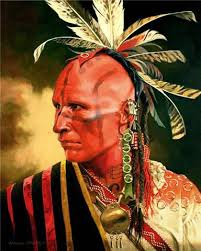In the never-ending frontier war(s) between Natives and Settlers, both sides resorted to any number of tactics to gain advantage, from sieges and ambushes to even psy ops. During the Northwest Indian War (1785-1795), there was no better psychological weapon than the presence or even the thought of Simon or James Girty. Particularly after the burning of Col. William Crawford in 1782, stories of Simon's cruelties were told and retold in taverns and around firesides as Girty sightings popped up from Kentucky and Virginia to Pennsylvania or Ohio. Native leaders soon caught on to the terror this one man inspired in so many minds and were quick to put his name to use.
Dunlop's Station, later Fort Colerain, was established on the east bank of the Great Miami River in 1790. They were on Shawnee land and constructed a series of blockhouses to protect against attacks. A detachment from the 1st Infantry Regiment garrisoned the blockhouse, but they wouldn't be much protection against an all-out onslaught by the likes of Little Turtle or Blue Jacket and their warriors. These two, along with other Native leaders, conceived a plan to attack both Dunlop's and Baker's Station, another frontier outpost. Though frontier sources put Simon Girty in command of both assaults, it's likely that he went along to provide the tacit support of the British Indian Department, and that he was at Baker's, not Dunlop's. On January 8, 1791, a surveying detail was attacked by Natives and one of the members of the party was captured. The remaining settlers and soldiers crowded into the blockhouses and prepared for what they knew was coming.
Luckily for them, a heavy snow began falling, which would prevent the Natives from attempted to burn down the wooden fortifications. On January 10, 1791, a force of Shawnee arrived at the fort, letting the Settlers understand that Girty was with them. They used the captured surveyor as their mouthpiece in a parley with the inhabitants of the blockhouse. Whether this man knew who Girty was, or had even met him, he was willing to take it on face value that the leader of the Natives forcing him to make demands to his comrades was the notorious frontier outlaw. Gunfire from both sides interrupted the parley and the captive was killed. The commander of the station had been able to send a runner to Fort Washington for reinforcements and hoped to buy time. They arrived next morning, and quickly fought off the besieging Shawnee. The ruse had been a clever one but ultimately failed.
American propaganda quickly made hay of the murder of the surveying party, including the man who'd been forced to serve as the mouthpiece for the Natives. Girty's supposed part was also fodder for reports and rumors. The Washington administration ordered that the blockhouse station be made into a proper military fort, but plans stalled. Only after the defeat of Tecumseh in 1811 was a full-blown fort constructed in the area. No part of the structure survives today.


No comments:
Post a Comment